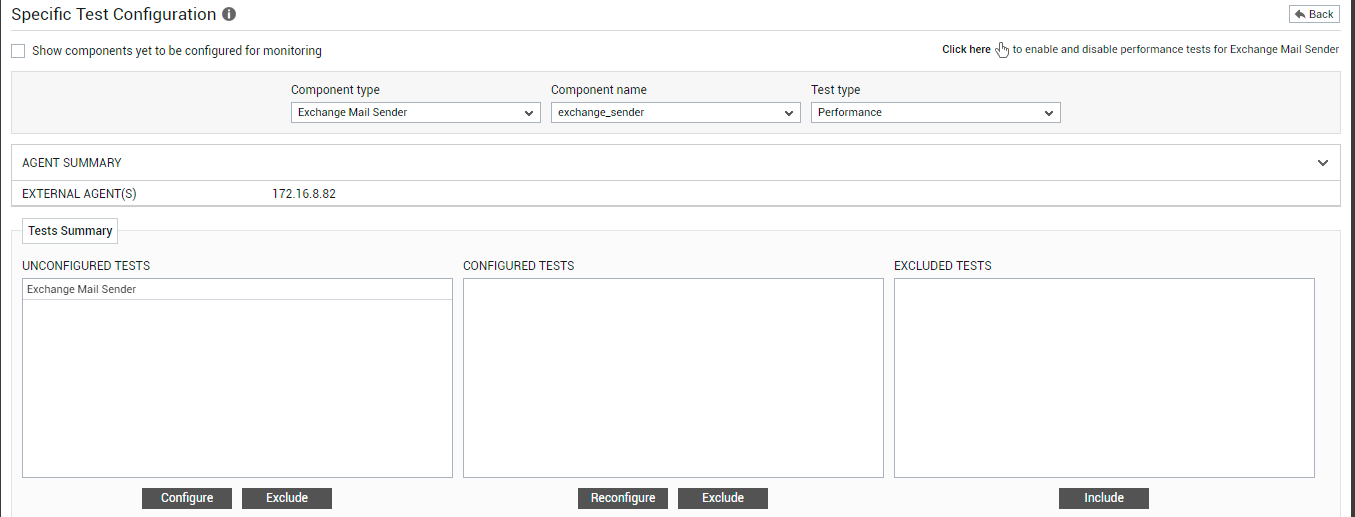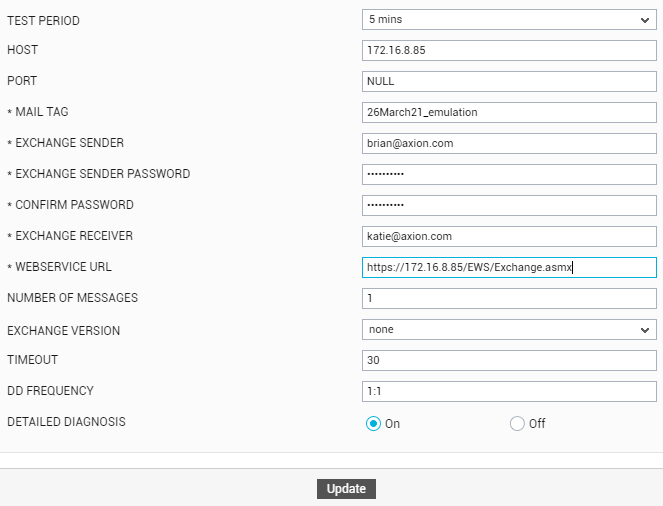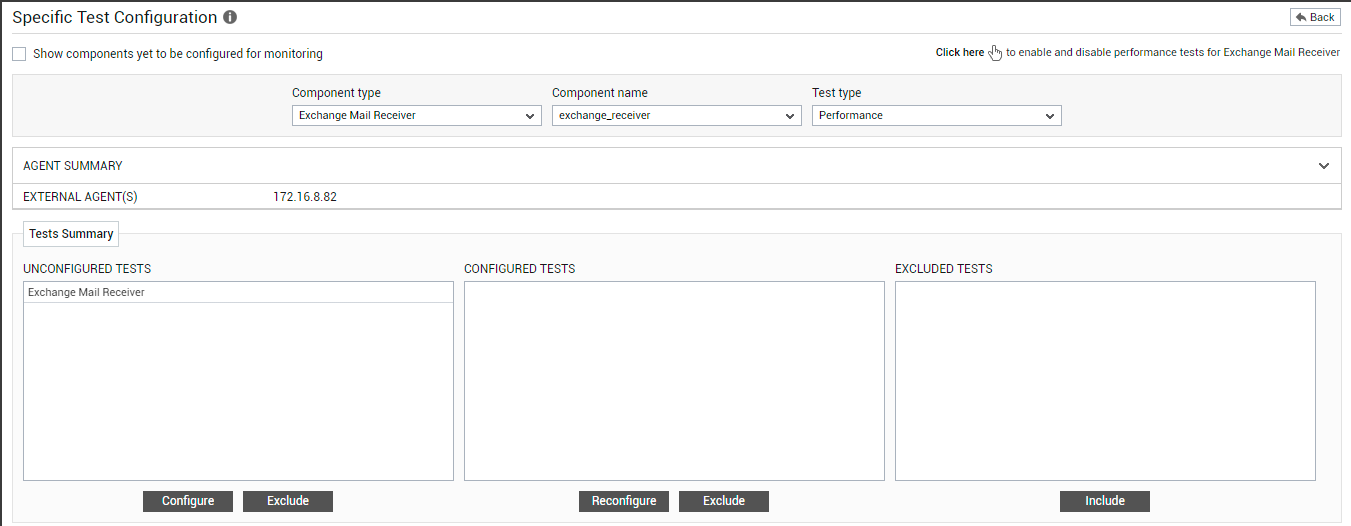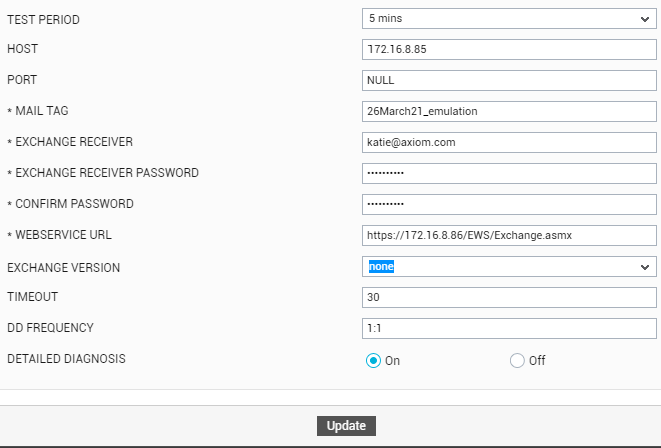Configuring the Exchange Mail Sender and Exchange Mail Receiver Tests
Now that the components have been added, proceed to configure the simulation. For that, you need to configure the Exchange Mail Sender and Exchange Mail Receiver tests mapped to the Sender and Receiver (respectively) components you just added.
Configuring the Exchange Mail Sender Test
Upon clicking the Add button when adding an Exchange Mail Sender component, Figure 1 will appear displaying the component you just added. Click on the ![]() icon corresponding to that component to configure tests for that component.
icon corresponding to that component to configure tests for that component.

Figure 1 : Viewing the details of the Exchange Mail Sender component that has been added
In the page that appears next (see Figure 2), select the Exchange Mail Sender test that is displayed in the UNCONFIGURED TESTS list box, and click the Configure button beneath.

Figure 2 : Selecting the Exchange Mail Sender test for configuration
Figure 3 will then appear, displaying the pre-configured and unconfigured parameters of the Exchange Mail Sender test.

Figure 3 : Configuring the Exchange Mail Sender test
The Exchange Mail Sender test periodically emulates an Exchange user sending a 'uniquely tagged' email to a configured receiver. In the process, the test reports metrics revealing the health of the mail sending function.
For the test to run and perform the simulation, you need to configure the test with the following:
- Indicate how frequently you want the simulation to run by selecting an option from the TEST PERIOD list.
- Specify a unique MAIL TAG using which you want to tag the emulated email. This enables the eG Enterprise system to keep track of the simulated email. To be able to simulate the email activity end-to-end - i.e., from transmission to reception - you should configure both the Exchange Mail Receiver and the Exchange Mail Sender tests with the same MAIL TAG.
- Next, proceed to indicate which mailbox on the Exchange server should send the emulated email. For this, configure the email ID of the Exchange MAIL SENDER. For best results, make sure that you provide the email ID of a valid mailbox on the Exchange server. You may want to configure a dedicated mailbox for the purpose of this emulation.
- To send an email, the eG external agent needs to access the configured sender's mailbox. In order to enable the agent to access the sender's mailbox, you need to configure this test with the access credentials of the sender. For this purpose, specify the password for access against Exchange MAIL SENDER PASSWORD. Confirm the password by retyping it in the CONFIRM PASSWORD text box.
- Next, you need to indicate who the email should be sent to. For that, enter the email ID of the receiver against Exchange MAIL RECEIVER.
- As mentioned already, the test uses the Exchange email service to perform the simulation. In order to enable the test to connect to this service, type the WEBSERVICE URL of that service.
- By default, every time this test runs, the eG external agent will send a single email from the configured sender to the receiver. This is why the NUMBER OF MESSAGES parameter is set to 1 by default. If required, you can configure the eG external agent to send out multiple emails to the receiver, every time the test runs. For this, you need to increase the value of the NUMBER OF MESSAGES parameter.
- By default, eG Enterprise auto-discovers the version of Microsoft Exchange in use in the target environment, and performs the simulation accordingly. This is why, the EXCHANGE VERSION is set to none by default. If required, you can explicitly specify the exact Exchange version here.
- By default, the TIMEOUT parameter of the test is set to 30 seconds. This means that, by default, the test will wait for a maximum of 30 seconds to connect to the Microsoft Exchange email service - i.e., to the configured WEBSERVICE URL. If the test is unable to connect to the email service even after the default period lapses, the test will automatically timeout. You can increase or decrease the timeout value, if you so need.
- DD FREQUENCY refers to the frequency with which detailed diagnosis measures are to be generated for this test. The default is 1:1. This indicates that, by default, detailed measures will be generated every time this test runs, and also every time the test detects a problem. You can modify this frequency, if you so desire. Also, if you intend to disable the detailed diagnosis capability for this test, you can do so by specifying none against DD frequency
-
To make diagnosis more efficient and accurate, the eG Enterprise embeds an optional detailed diagnostic capability. With this capability, the eG agents can be configured to run detailed, more elaborate tests as and when specific problems are detected. To enable the detailed diagnosis capability of this test for a particular server, choose the On option against DETAILED DIAGNOSIS. To disable the capability, click on the Off option.
The option to selectively enable/disable the detailed diagnosis capability will be available only if the following conditions are fulfilled:
- The eG manager license should allow the detailed diagnosis capability
- Both the normal and abnormal frequencies configured for the detailed diagnosis measures should not be 0.
Once the test is configured, click on the Update button to save the changes. Next, proceed to configure the Exchange Mail Receiver test mapped to the Exchange Mail Receiver component.
Configuring the Exchange Mail Receiver Test
Upon clicking the Add button when adding an Exchange Mail Receiver component, Figure 4 will appear displaying the component you just added. Click on the ![]() icon corresponding to that component to configure tests for that component.
icon corresponding to that component to configure tests for that component.

Figure 4 : Viewing the details of the Exchange Mail Receiver component that has been added
In the page that appears next (see Figure 5), select the Exchange Mail Receiver test that is displayed in the Unconfigured Tests list box, and click the Configure button beneath.

Figure 5 : Selecting the Exchange Mail Receiver test for configuration
Figure 6 will then appear, displaying the pre-configured and unconfigured parameters of the Exchange Mail Receiver test.

Figure 6 : Configuring the Exchange Mail Receiver test
The Exchange Mail Receiver test periodically emulates a user on an Exchange mail server receiving an email that is uniquely tagged. In the process, the test reports metrics revealing the health of the mail receiving function. This test takes the following parameters:
- Indicate how frequently you want the simulation to run by selecting an option from the TEST PERIOD list.
- Specify a unique MAIL TAG using which you want to tag the emulated email. This enables the eG Enterprise system to keep track of the simulated email. To be able to simulate the email activity end-to-end - i.e., from transmission to reception - you should configure both the Exchange Mail Receiver and the Exchange Mail Sender tests with the same MAIL TAG.
- Next, proceed to indicate which mailbox on the Exchange server should receive the emulated email. For this, configure the email ID of the Exchange MAIL RECEIVER. Make sure that you specify the same Exchange MAIL RECEIVER for both the Exchange Mail Sender and Exchange Mail Receiver tests.
- The test should be able to access the receiver's mailbox, so it can check whether/not mails with the MAIL TAG have been received by it. To facilitate this check, specify the password of that mailbox against Exchange MAIL RECEIVER PASSWORD. Confirm the password by retyping it in the CONFIRM PASSWORD text box.
- As mentioned already, the test uses the Microsoft Exchange email service to perform the simulation. In order to enable the test to connect to this service, type the WEBSERVICE URL of that service.
- By default, eG Enterprise auto-discovers the version of Microsoft Exchange in use in the target environment, and performs the simulation accordingly. This is why, the EXCHANGE VERSION is set to none by default. If required, you can explicitly specify the exact Exchange version here.
- By default, the TIMEOUT parameter of the test is set to 30 seconds. This means that, by default, the test will wait for a maximum of 30 seconds to connect to the Exchange semail service - i.e., to the configured WEBSERVICE URL. If the test is unable to connect to the email service even after the default period lapses, the test will automatically timeout. You can increase or decrease the timeout value, if you so need.
- DD FREQUENCY refers to the frequency with which detailed diagnosis measures are to be generated for this test. The default is 1:1. This indicates that, by default, detailed measures will be generated every time this test runs, and also every time the test detects a problem. You can modify this frequency, if you so desire. Also, if you intend to disable the detailed diagnosis capability for this test, you can do so by specifying none against DD frequency.
-
To make diagnosis more efficient and accurate, the eG Enterprise embeds an optional detailed diagnostic capability. With this capability, the eG agents can be configured to run detailed, more elaborate tests as and when specific problems are detected. To enable the detailed diagnosis capability of this test for a particular server, choose the On option against DETAILED DIAGNOSIS. To disable the capability, click on the Off option.
The option to selectively enable/disable the detailed diagnosis capability will be available only if the following conditions are fulfilled:
- The eG manager license should allow the detailed diagnosis capability
- Both the normal and abnormal frequencies configured for the detailed diagnosis measures should not be 0.
Once the test is configured, click on the Update button to save the changes.
Finally, sign out of the eG admin interface.
